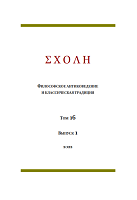МАКСИМ ТИРСКИЙ О ДЕМОНЕ СОКРАТА (OR. 8–9)
MAXIMUS OF TYRE ON SOCRATES’ DAIMONION (OR. 8–9)
Author(s): Alexei GaradjaSubject(s): Ancient Philosphy, Translation Studies, Rhetoric
Published by: Новосибирский государственный университет
Keywords: Maximus of Tyre; Socrates; Plato; demonology;
Summary/Abstract: Maximus of Tyre (fl. late 2nd century ad) is most poorly and confusedly attested in ancient sources. The best testimony to be found is his extant collection of 41 Orationes, or Dissertationes, addressing a wide range of topics, including the issue of ‘Socrates’ daimonion’ (Or. 8–9), which has been also dealt with by Maximus’ fellow Platonists of the Middle stage Plutarchus of Chaeronea (46 – after 119), in De Socratis demonio, and Apuleius of Madauros (c. 124 – c. 170), in De deo Socratis. All of them, with slight variations, consider demons intermediary beings shuttling between heavens and earth, gods and humans; at one point, Maximus compares them to translators who ensure contacts between people of different cultures. Maximus’ Platonism mainly manifests in his attempts to mould his own writings in the spirit and style of Plato’s works. The style is paramount for Maximus, him being not only a Platonist, but also a prominent representative of the Second Sophistic. As an eclectic philosopher, he introduces into his writings sundry Aristotelean and Stoic threads interwoven with Platonic warp and woof. Revealing himself a widely educated person, Maximus shows a good knowledge of Plato as well as other ancient authors, whose many fragments are extant solely thanks to his quotations. Maximus is scarcely known in the Russian language: a few translations of the last century are based on an obsolescent edition. As an appendix, a new Russian translation of Or. 8–9 based on thoroughly corrected editions of Maximus’ text is provided.
Journal: ΣΧΟΛΗ. Философское антиковедение и классическая традиция
- Issue Year: XVI/2022
- Issue No: 1
- Page Range: 317-333
- Page Count: 17
- Language: Russian

